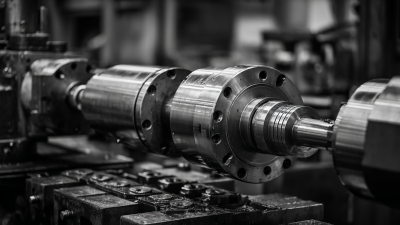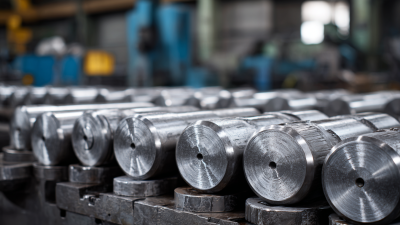Leave Your Message
-
Phone
-
E-mail
 Hot forging, a pivotal process in modern manufacturing, offers a multitude of advantages that enhance product quality and production efficiency. According to a report by the Grand View Research, the global metal forging market was valued at USD 82.56 billion in 2021 and is projected to grow at a CAGR of 4.5% from 2022 to 2030, highlighting the rising demand for forged components across various industries. Hot forging parts are known for their superior strength and durability, which can significantly reduce the likelihood of mechanical failures in critical applications such as automotive and aerospace. Furthermore, statistical analyses indicate that the use of hot forging can decrease material waste by up to 30%, demonstrating its efficiency in resource management. As manufacturers increasingly prioritize sustainability and performance, understanding the benefits of hot forging parts becomes essential for leveraging its full potential in today’s competitive landscape.
Hot forging, a pivotal process in modern manufacturing, offers a multitude of advantages that enhance product quality and production efficiency. According to a report by the Grand View Research, the global metal forging market was valued at USD 82.56 billion in 2021 and is projected to grow at a CAGR of 4.5% from 2022 to 2030, highlighting the rising demand for forged components across various industries. Hot forging parts are known for their superior strength and durability, which can significantly reduce the likelihood of mechanical failures in critical applications such as automotive and aerospace. Furthermore, statistical analyses indicate that the use of hot forging can decrease material waste by up to 30%, demonstrating its efficiency in resource management. As manufacturers increasingly prioritize sustainability and performance, understanding the benefits of hot forging parts becomes essential for leveraging its full potential in today’s competitive landscape.
 Hot forging is a critical process in modern manufacturing, primarily due to its significant role in enhancing material strength and durability. When metals are forged at elevated temperatures, they become malleable, allowing them to be shaped more easily under compression. This process reduces the likelihood of defects, such as porosity or micro-cracking, which can compromise the integrity of the finished product. According to a report by the Forging Industry Association, components produced through hot forging can exhibit up to 30% greater strength compared to those made through traditional machining processes, making hot forged parts particularly appealing for high-stress applications in industries such as automotive and aerospace.
Hot forging is a critical process in modern manufacturing, primarily due to its significant role in enhancing material strength and durability. When metals are forged at elevated temperatures, they become malleable, allowing them to be shaped more easily under compression. This process reduces the likelihood of defects, such as porosity or micro-cracking, which can compromise the integrity of the finished product. According to a report by the Forging Industry Association, components produced through hot forging can exhibit up to 30% greater strength compared to those made through traditional machining processes, making hot forged parts particularly appealing for high-stress applications in industries such as automotive and aerospace.
Additionally, hot forging can lead to improved grain structure within metals, which further contributes to the overall mechanical properties of the parts. The American Society for Testing and Materials (ASTM) states that forged products typically display superior fatigue resistance and impact toughness, essential qualities for components that endure heavy loads and harsh operating environments. By utilizing hot forging techniques, manufacturers can produce parts that not only meet but often exceed the rigorous performance standards required in today’s competitive markets, promoting advancements in technology and product reliability.
Hot forging is a pivotal technique in modern manufacturing, offering several key advantages over traditional methods. One of the most significant benefits is the enhancement of material properties. When metals are heated and shaped under high pressure, their internal structures refine, resulting in improved strength and ductility. This leads to components that can withstand higher loads and resist fatigue, making hot-forged parts ideal for critical applications in industries like aerospace and automotive.
Another advantage is the reduction in waste material. Traditional machining methods often involve cutting away excess material, which can be inefficient and costly. In contrast, hot forging processes typically produce near-net-shape parts, minimizing scrap and maximizing yield. This not only contributes to sustainability by reducing waste but also lowers production costs and time, allowing manufacturers to achieve greater efficiency throughout the production cycle. The ability to produce complex shapes with fewer processing steps further solidifies hot forging's position as a superior manufacturing method.
This bar chart illustrates the key advantages of hot forging compared to traditional manufacturing methods. The metrics assessed include strength, machinability, cost efficiency, material utilization, and production speed, showcasing hot forging's significant benefits in modern manufacturing processes.
Hot forging is a pivotal process in modern manufacturing that offers significant cost savings and enhanced production efficiency. By applying heat to metal, manufacturers can achieve a more malleable material that can be shaped without cracking, thus reducing the material waste typically associated with cold forging methods. The elevated temperatures enable better flow of the material, allowing for more complex geometries and designs to be created without requiring excessive processing time or tooling alterations.
The cost-effectiveness of hot forging is further underscored by its ability to minimize post-processing requirements. The precision achieved during the forging process reduces the need for additional machining, which not only cuts down labor costs but also streamlines the entire production cycle. Moreover, the durability and strength of hot-forged parts often lead to lower failure rates, thus decreasing the costs associated with repairs and replacements. This quantitative advantage positions hot forging as a crucial element for manufacturers aiming to optimize their operations and enhance their bottom lines.
Hot forging is a crucial manufacturing process, especially in the aerospace and automotive industries, where precision and strength are paramount. In aerospace, hot-forged components are commonly used in critical applications such as engine parts and structural elements. The ability to create complex shapes with increased toughness and improved mechanical properties makes hot forging an ideal choice for components that must withstand extreme stress and temperature variations. For instance, titanium and superalloys are often hot forged to achieve the necessary performance standards for flight.
In automotive manufacturing, hot forging is extensively utilized for producing high-strength parts like crankshafts, gears, and suspension components. This process not only enhances the material's overall properties but also increases the efficiency of production by reducing waste. Components made with hot forging exhibit superior fatigue resistance, which is vital for vehicles operating under harsh conditions.
**Tips:** When considering hot forging for your production needs, evaluate the material compatibility with the process for optimal results. Additionally, collaborating with experienced engineers can help in designing parts that maximize the benefits of hot forging while minimizing costs. Always assess post-forging treatments that can further enhance the durability of the final product.
| Dimension | Aerospace Applications | Automotive Applications |
|---|---|---|
| Material Type | Titanium, Aluminum Alloys | Steel, High-strength Alloys |
| Typical Products | Landing Gear, Engine Components | Crankshafts, Gearboxes |
| Temperature Range | 800-1200 °C | 900-1300 °C |
| Benefits | Improved Strength-to-weight Ratio, Enhanced Fatigue Resistance | Reduced Weight, Increased Durability |
| Production Efficiency | Lower Cycle Times, Consistent Quality | Higher Throughput, Lower Material Waste |
The future of hot forging technology holds significant promise for the manufacturing sector, particularly as industries increasingly strive for efficiencies and cost-effectiveness. Recent studies indicate that the global hot forging market is expected to reach approximately $29 billion by 2026, driven by expansions in sectors like automotive, aerospace, and heavy machinery. This upward trend is largely attributed to advancements in forging techniques and the introduction of innovative materials that enhance the strength-to-weight ratio of finished products.
Furthermore, the integration of smart manufacturing technologies, including AI and IoT, is poised to transform hot forging processes. According to a report by MarketsandMarkets, the adoption of Industry 4.0 practices could lead to a reduction in production costs by up to 20% over the next five years. As manufacturers leverage real-time data to optimize workflows and predict maintenance needs, the efficiency of hot forging operations can be greatly enhanced, resulting in higher quality products with reduced lead times. This evolution not only enhances productivity but also drives sustainability by minimizing material waste and energy consumption in the forging process.







